So you’ve made the tree change, shifted to the dream country block or taken over the farm now Dad has retired. While the peace and quiet is great, the fringe of grid power can prove problematic.
Today we’ll look at ways to take tenuous SWER connections from skinny to muscular. Everyone deserves cheaper, cleaner power; you just need a plan and a sensible budget.
Recently, we addressed skinny suburban supply cables and solar for strata. While rural setups face similar issues, the solutions differ when you need more capacity and, fortunately, have more space to maneuver.
Our Farm Was Coke Fired
In the early 1950s, my Grandpa ditched kerosene lamps & electrified them with a thoroughly up-to-date 32-volt DC “lighting set”. Sixteen lead-acid batteries in rebuildable glass jars, charged not by a windmill but by a 2 HP petrol engine and 800 watt brushed generator. So modest were these systems, if you could afford appliances, they were often “plugged in” to the light sockets.
Heavy lifting was left to coke (baked coal) for the AGA stove, later converted to oil. This was the heart of the house, it heated the kitchen and the hot water service in the roof.
In 1959, modernity arrived with publicly subsidised mains electricity. Nanna was so relieved to turn the stove off in summer.
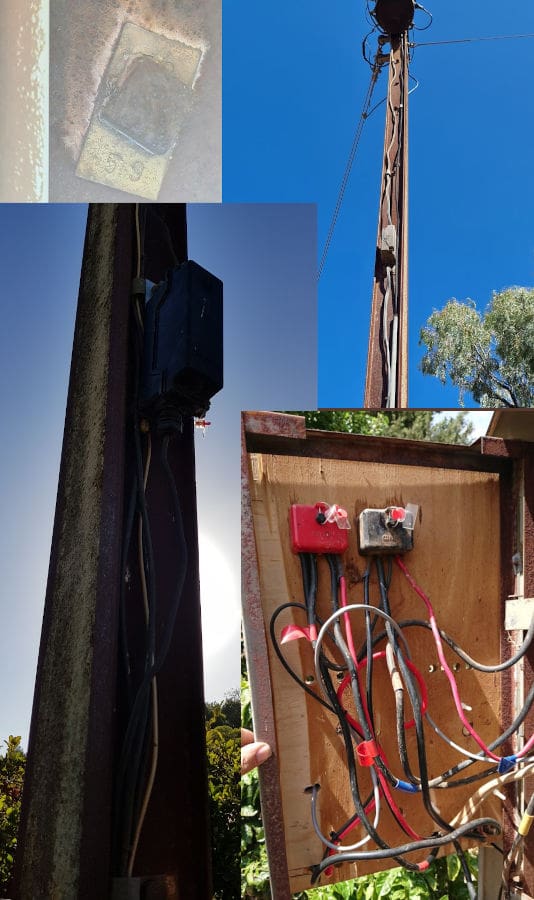
The tag shows 1959 with vintage service wiring. Elsewhere, I’ve found RED cable used for the neutral. Single insulated, faded, crumbling in the sun, but SAPN are blind to their own non-compliance.
Basic Electrification Was A Public Good
The SWER system, or Single Wire Earth Return, is very straightforward: it sends 19,000 volts through a transformer and completes the circuit by plugging it straight into the dirt. Broadly spaced posts and one very thin, taut steel wire made widespread electricity affordable for everyone.
This economy came with a trade-off: limited power capacity. Originally, managing a 3.6kW hot water system overnight and a fridge or stove during the day with a 5kVa transformer (providing 20 amps single phase) was enough. After all, houses didn’t even have power points in the bedrooms. Today, that wouldn’t cut it.
Electrification Is Difficult With Only Half The Supply
Most Australians have 63 amps or 14.5kW available (or triple that for a 400-volt 3-phase supply), but SWERs can sag badly, browning out before tripping off at 45 amps. They suffer similarly when exporting solar back into the network, so they are often export-limited.
Worse still, the DNSPs limit total inverter capacity on SWER to 5kW mostly, so even connecting solar is hamstrung compared to 10kW systems in town.
There are some “2 phase” SWER transformers, which are 180° split phase, best thought of as two parallel single phase supplies.
EV’s Will Cut Both Ways
To accommodate electric vehicles (EVs), we must manage legacy infrastructure to endure more throughput, which is especially important when a standard EV charger may use 30% more power than many SWER transformers can supply for 10 hours straight.
EVs have dirty big batteries, so there are opportunities for either charging up in town and bringing a tank full of fuel home or simply having more storage available that you can access via V2L or, hopefully, soon, the higher capacity of V2G.
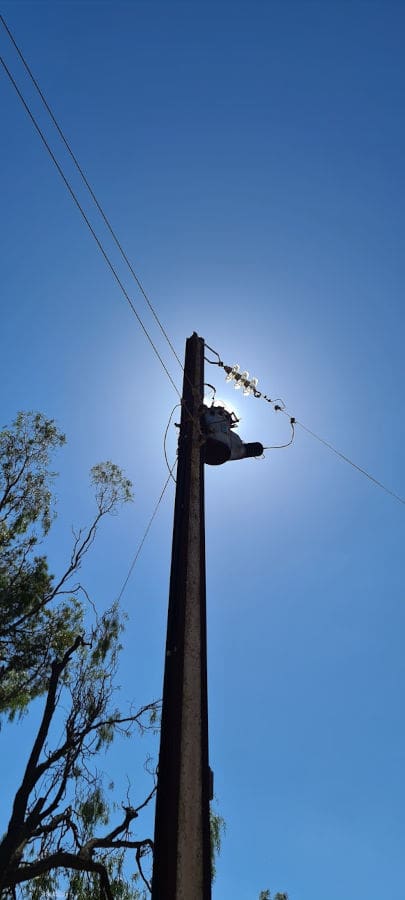
5kVa SWER transformer. 65 years later, it’s still a shining example.
What’s The Way Forward?
Farmers have always been savvy, so I’ll bet my boots that agricultural EVs will be popular soon. As soon as they’re available, quiet utes & reliable e-motor cycles will need charging though.
The Basic Solution
Reinforcing a SWER supply using a battery hybrid system to stiffen up what’s already available will be the most economical.
Modern, lightweight battery hybrid inverters like Fronius, Sungrow & GoodWe offer excellent performance on par with suburban pricing; however, in some jurisdictions, a 10kW single-phase inverter won’t be network-approved, and I couldn’t recommend running one off-grid. They’re not designed for it.
Getting Serious Will Need More Resources
Significant increases in energy consumption will be met with generation and storage on-site, while the existing SWER will be used for backup.
Having built, expanded, and maintained remote area power systems for years, I invariably used diesel generators to maintain security, either running daily to get the cool room down to temperature and charging batteries or doing random hours responding to long cloudy weeks in winter.
Backup generators are the most troublesome but equally essential part of remote area power. However, a grid connection for backup will be more reliable, electrically stable and cheaper.
I’ve transformed a farmer’s experience. Living beyond Ceduna put him at the very western extreme of the national network. With a saggy 5kW supply his welder struggled and didn’t work at all with the air compressor.
Using a relatively small battery and my favourite Selectronic SpPro, suddenly there was 12kW of surge capacity plus the SWER supply. With 19kW available the welder would throw beautiful hot arcs. All the workshop equipment worked better and when his neighbour’s tractor mowed down a power pole, the lights didn’t even flicker.
This is what reliability looks like
3 Phase Is Feasible
It’s easy enough to create a 3-phase supply, to run specific machinery, or, given the budget, power a village of 30 houses using three grid-forming inverters. This is the approach the network companies themselves use to take hamlets or individual houses “off-grid” and avoid costly maintenance for poles and wires and bushfire liability, too.
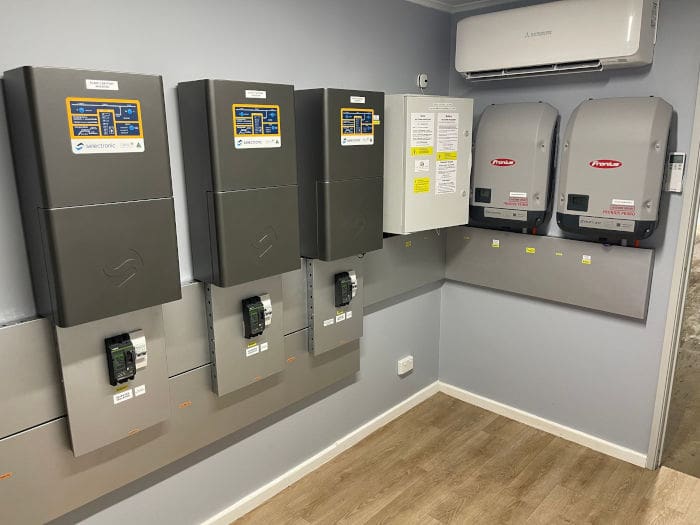
3 x Selectronic for 3 phase. 2 x Fronius for solar.
Treating The Grid With Contempt
Genuine off-grid solutions can be infinitely more capable, resilient, expandable and expensive. However, they can be 100 times more cost-effective than paying for grid augmentation if you need an 11kV distribution line.
Selectronic (or perhaps Victron) systems don’t need the authorities’ approval; better yet, DC-coupled solar means you can keep adding arrays until the cows come home.
Uncle Arni’s ready reckoner for pricing top-quality Australian-made off-grid solar power. It might sound expensive but grid hybrids can be half the price when you don’t need huge batteries or a 15kVa diesel generator costing $15,000. STC incentives still mean the actual solar panels are dirt cheap.
The Power Is Now Yours
Solar power is cheaper than ever, and the technology is now incredibly capable. My best advice to those on a skinny rural grid connection is to seek out a quality installer. One who can help identify what you need, will answer the phone and can swing by for after-sales service without much hassle.
Remember, when your generator won’t start, the phone rings out, and you can hear your freezer defrosting, skimping on quality could cost you three times more before you circle back to that first quality quote.

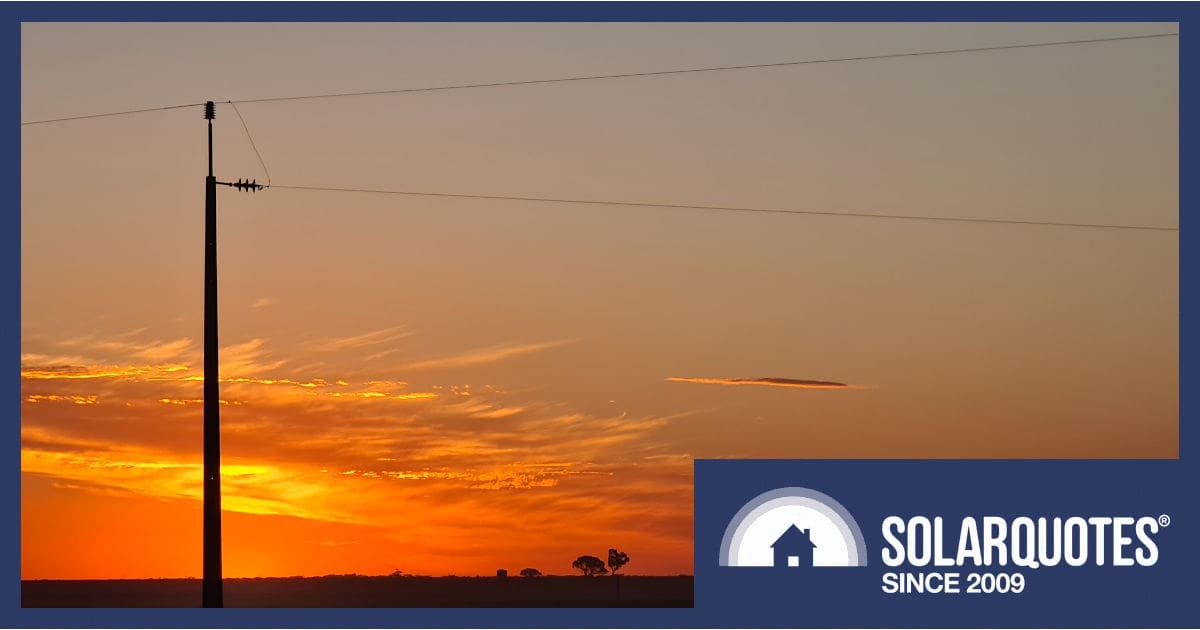
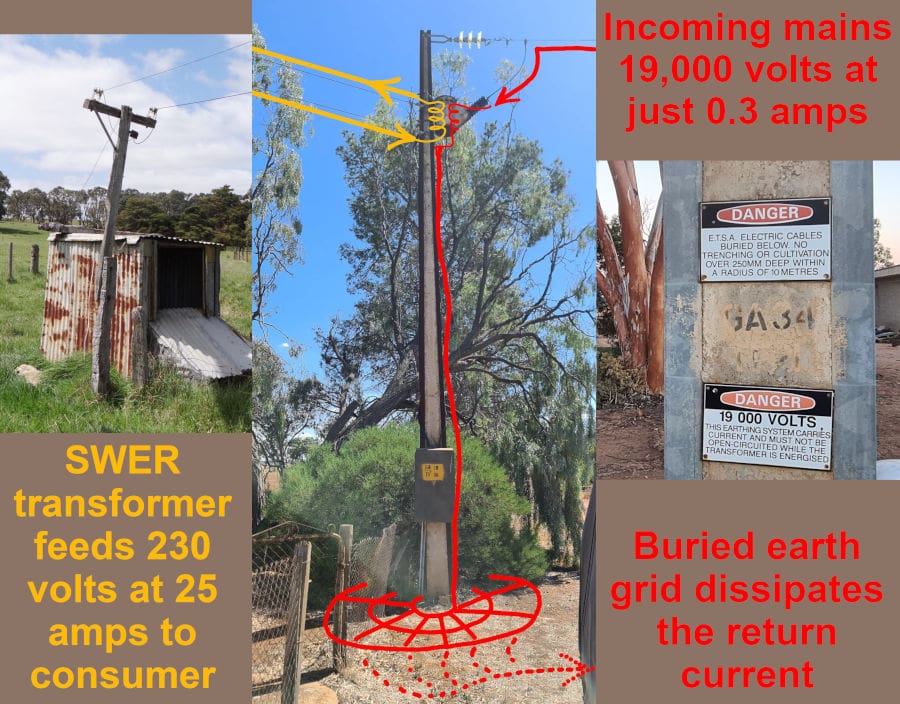
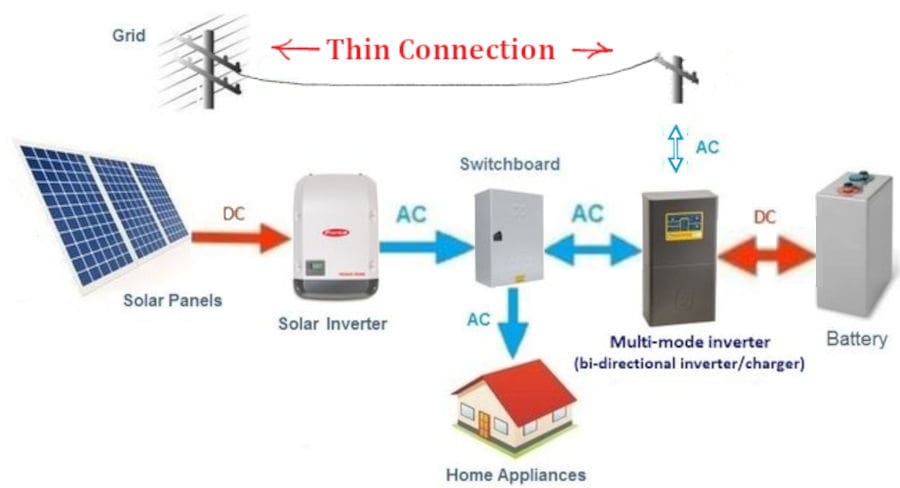
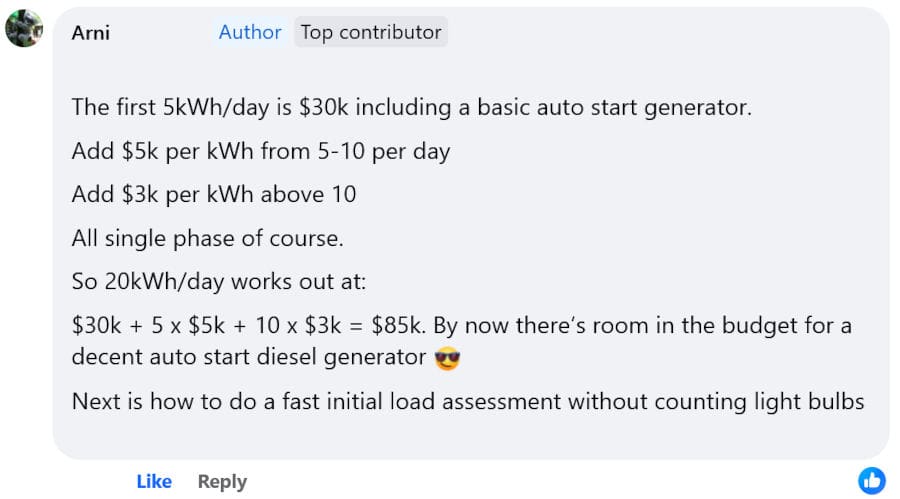
 RSS - Posts
RSS - Posts



We have just moved to Central QLD to retire. We are on the normal grid supply and have just installed 10KW panels (4 kW facing east, 6 facing west), a Fronius Gen24plus 8 kW inverter and 19.1 kWh battery stack. This has been running for just on a month and we have not drawn any power from the grid at all. We also charge our PHEV as well as running a pool chlorinator 6 hours a day. The weather has been quite variable, mostly cloudy, the best days (only 2), the system generated just over 51kWh. We still export power to the grid, over 15kWh some days, very little other days but there has only been one day where the battery only charged to 80%, usually it is at 100% by early afternoon, that particular day I charged the car in the afternoon. It takes a maximum of about 11kWh. All this means is that the Inverter basically supplies all the power to the house 24/7. I wonder if this will be considered off-grid use as far as the warranty is concerned. I have not asked that question to the supplier, I would be interested in your opinion.
Hi Horst,
Fronius specify that if the grid is completely missing for more than 20% of the time they won’t offer a warranty. That is if you had a blackout or you were switching the mains supply off for 2 days a week they would be dubious.
Provided the grid is still there and the inverter can use it to maintain stability most of the time then you’ve got nothing to worry about.
Hi Anthony,
I can’t quite get my head around what the difference in load/stress on the inverter would be. Off grid, it runs everything, on grid with sufficient solar input or adequate charge in the battery, it really works exactly the same way. So why would they differentiate between those modes as far as warranty is concerned.
Hi Horst,
It’s really about the outright peak loads as I understand it.
The grid is incredibly gutsy and when you look at an ordinary circuit breaker it’s rated for a given current between 10 and 63 amps for instance, but it’s also rated for 6000 amps. The idea being that if you have a dead short circuit the breaker must be able to open a 6kA fault current without bursting into flames… because the grid can supply that.
Imagine with a grid hybrid you may have a pretty gutsy air compressor rated for 3.4kW running load on a 15 amp circuit. With a capacitor start motor this unit could draw six or eight times it’s running current, so at the instant the pressure switch closes you theoretically need 100 amps or 23kW.
For a few fractions of a second a 5kW grid hybrid system rated for a 6kW surge will try it’s best, but it really needs the grid, to help get the compressor rolling.
A 5kW SpPro is rated for 12kW surge, and with a big heavy transformer design topology it’s going to handle being stabbed with that load, where a lightweight hybrid will struggle.
It’s a bit like watching a crowd of carpenters errect a house. Their nail guns need a 2.2kW compressor which in turn is run by a generator with a wailing 10kW petrol engine.
When the compressor starts you can hear the generator stumble because it’s been stabbed with a huge surge load. The generator is relying on some inertia, having 10kg(?) of rotor spinning at 3000rpm gives it the instantaneous grunt to get things moving while the governor opens the throttle to throw more petrol on the problem.
Lightweight grid hybrids offer synthetic inertia, but there’s not that much built in.
Hi Anthony
Are you saying that selectronic or victron ( multiplus and quattro) don’t need approval from SAPN here in SA to connect to their network. These inverters are fantastic for power assisting low capacity mains but always thought approval was required from SAPN which I thought they would not give due to not being CEC approved. I would put one on in a flash if I could for the same reason of running high demand workshop equipment on a way too small submain.
Thanks Andrew Ayles (electrician in SA and CEC approved off grid installer)
There certainly are some 5kW SPMC481s on the network out there, I’ve installed them but I can’t recall what we used to meet the “smarter homes” requirements, that had to be retrofitted. One of the guru’s from SAPN (George? They refer to him as the wizard) has one on his own place but getting a new approval from SAPN as a hybrid may be tricky under the latest flexible export rules.
The alternate solution is an “off grid” configured SpPro (like the bigger SPMC482) which uses a 48v forklift battery charger as a pretend generator.
In both cases the AS4777:2015 rules sadly mean you can’t export energy from the DC side of the SpPro, however conventional grid connected solar is perfectly fine.
Victron also had an approved solution which I have installed with LG Chem or Redflow Z Cell but they’ve fallen off the CEC list, apparently because they refuse to offer a configuration which is preset with “Australia A” grid connect settings. The DNSPs don’t like the idea that someone can get into a Victron and play with the power quality as I understand it, so Victron can’t be arsed supporting that market. Nor will they give a warranty on a new 3kW Multiplus with LG Chem battery, but that’s another story.
Shoot us an email.
Anthony’s article can equally apply to detached homes in suburbia. Especially salient is his comment re commercial hybrid inverters non supported utility as a offgrid alternative. I paid $1500 more for a supposedly superior European hybrid inverter over a cheaper hybrid sungrow inverter only to find out after installing that the European brand not only charges you a yearly fee for accessing your own data. But takes 60 seconds to change over to feed loads from battery if there is a grid outage. Whereas the sungrow changes over in 20 mili seconds ( 30,000 x faster than EU brand) and has no fees to access system data.
Hi Lyle,
I have used Fronius inverters on all of the projects I really care about and found them excellent. Last I checked the monitoring was free, and alert emails are standard for things like earth leakage alarms but premium features such as long term detailed history were available via subscription, however your installer will have that access to diagnose problems if need be.
Fronius have recently updated firmware to significantly reduce the delay time in an outage. (SolarEdge functions the same way) I often point out that a blackout is an unmissable analogue warning to curtail your consumption & preserve battery life. ie a 15 second outage is preferable to having your freezer defrost because nobody noticed the grid had disappeared and the air conditioning has chewed the battery up.
Being a parallel hybrid also means that if the Fronius system fails/goes flat there is no intervention needed to turn the house back onto mains power.
It’s swings and roundabouts but I’d have hoped your installer had explained these things prior.
I am both:
a) the target market for this article
b) not a complete idiot
Most of this article went straight over my head. Way too much assumed knowledge for your audience.
Hi Shane,
Sorry if it’s not immediately apparent but I struggle to get everything into a 1000 word target. Please head over and read the “skinny connections article” for more context
https://www.solarquotes.com.au/blog/solar-skinny-grid-connections/
And fire some details of your existing house/solar/plans at us. Any questions you have can be answered in our FAQ section or we’ll write a whole post if need be.
Thanks for the feedback.
Honestly, same.
The beginning of the article gave me the impression SWER was some novelty that no longer existed.
Perhaps the back story could be trimmed to paint the present-day reality sooner. This might help readers comprehend the different components and how they address some of the same/different challenges this type of confirmation faces, compared to a typical stable grid+solar environ.
Hi GTH,
We’re working on some case studies for this as it’s far too broad to cover in a single post
Cheers
SWER lines with the connection limit of 5kw of inverter size also limit the solar array we can grid connect to 6.6kw.
Fitting a battery and correct inverter will enable greater PV to be fitted.
Can you elaborate on just how big we can go with extra PV while keeping the convenience of grid backup without the need to purchase a generator and the complications that seem to be inherited with auto start (and stop).
Personally i think it is much cheaper to spend $350 per year on grid backup than the generator backup, with the added advantage of being able to offset that supply charge with surplus summer PV generated export.
For me I think 20kw of panels to supply all my daily needs (using 20kwh/day in a full electric home), but only need 6kwh of storage to save not being burnt by high peak tariffs.
The resistive electric HWS can run on the surplus daytime generation without the high cost of Heat pumps which are Energy efficient NOT cost efficient, while the large array will supply all my daily/nightly needs even on the worst 15 solar days per year. The small size battery only needs to get me through 1 night, as it will always recharge next day with such a large (and economical build) PV array.
Hi Tim,
It will vary from place to place with DNSP rules and the approach you’d like to take. The right 5kW hybrid will take between & 7.5 & 12kW of solar I think, provided you have a battery connected. That’s a certainly the most economical way.
However I also know of systems where a 5kW Selectronic SpPro and 5kW Fronius Solar inverter/7.5kW solar combination form an approved grid hybrid system, with 14 x 3kWh batteries. This is what the DNSP know is on their network, but it’s basically a glorified battery charger.
The batteries are shared with another 2 x 7.5kW SpPros and 3 x 8kW Fronius Solar inverters in an off grid configuration that actually runs the house. Budget wasn’t the primary driver on this system as you might imagine but it shows what’s possible.
There’s no diesel involved because as you rightly observe, just servicing a generator every year would cost more that $365 even before you add capital or fuel cost.
Can you use selectronic inverter on grid connection in SA
Hi Darren,
There certainly are some 5kW SPMC481s on the network out there, but getting a new approval from SAPN as a hybrid may be tricky under the latest flexible export rules.
The alternate solution is an “off grid” configured SpPro (like the bigger SPMC482) which uses a 48v forklift battery charger as a pretend generator.
In both cases the AS4777:2015 rules sadly mean you can’t export energy from the DC side of the SpPro, however conventional grid connected solar is perfectly fine.
Really it just comes down to budget and preference.
Just a quick question for Anthony re bolstering a ‘thin’ grid connection.
Scenero :
There is an abundance of all in one offgrid 5000w ish switch mode inverter/ chargers/ ATS available. I few names to mention is Growatt es 5000, DEYE, Letovo even PowMr etc. most are RCM c-tick but none are CEC approved.
Anyway when you install one of these ‘all in one’ inverters above into a submain off the utility panel, and have a dedicated offgrid panel for output with it own earth an MEN link etc. then connect applicable circuits in your home to the inverters panel , i.e. circuit that have no connection via earth, neutral or active conductors to ‘grid’ circuits in the home.
When insufficient and solar and battery SOC or overload occur these inverters draw utility power from their submain connection to the homes main panel. Essentially in helper mode; sometimes utility helping inverter in inverter mode , sometimes inverter helping utility in bypass mode.
My question is: are these non Grid Tied inverters considered an appliance in the main panel or is it considered a energy infrastructure inverter per-se.
Hi Lyle,
Problem with the cheap gear is that it’s unlikely to have a connection approval for the DNSP. If you’re looking at anything less than a Victron I’d be uncomfortable about reliability.
We’ll outline some scenarios soon but as an example, you can’t have two MEN links and main switches on the same building.
For some the compliant way around DNSP rules is to build a grid forming system that has a relay to call a generator. When it needs backup it’ll actually call a 4.6kW forklift battery charger which is below the 20a threshold you need to energise loads that don’t require formal permission to switch.
We’re working on some case studies for this as it’s far too broad to cover in a single post
Cheers
Thanks for the comprehensive reply. The 20 amp (230 vac) battery charger is novel and under the over 20amp appliance rules in Queensland. Be reasonable easy to set up with the inverter’s generator dry contacts and an AC contractor.
– cheers